The Durango 1836 medio escudo – addition to the catalog
by Angel Smith
Customarily, while assembling our collections, we rely on the most popular or current reference available to mark our haves and needs and thus once an entry is filled, we will likely tend to ignore any specimens that turn up in the future, except perhaps when looking to upgrade them. As a result, we may miss the chance to encounter different varieties of a given specimen. Such is the case of the Durango ½ Escudo dated 1836 (this being the only mint that struck medios escudos for that particular year), which can be found listed in older references as a “1836 Do RM 6 over 4”footnote}Buttrey, T. V. and Hubbard, Clyde. A Guide Book of Mexican Coins 1822 to Date, 1st Edition (1969). Western Publishing Company, Inc. Withman Hobby Division, Racine, Wisconsin, U.S.A. and subsequent editions., or additionally as a “1836/5/4 Do RM/L”footnote}David C. Harper, Editor. 2015 North American Coins & Prices. 24th edition. Krause Publications.. As you will see, the most popular available listings noted above, which may be supplemented by the more specialized reference by Richard A. LongRichard A. Long. Gold coins of the early Mexican Republic, 1823-1873. Wegfred Publications, North Bend, Oregon, 2004 that lists the coin as: “1836/4”, “1836/1” and also as the mentioned over-assayer “RM/L”, as well as other listings that may be scattered in several auction catalogs, price lists, etc. tend to deal with the obverse or “hand on book” side, and more particularly the interpretation of the different overdates, over- assayer and a combination of both, something that I will not try to mess with nor clarify in this short report, but they do not pay attention to the reverse or “eagle” side.
To my surprise, while recently researching the 1836 medio escudo, I realized that none of the major sources discussed above list the following interesting varieties found on the reverse:
“SKINNY HEAD SNAKE”
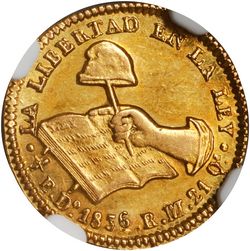
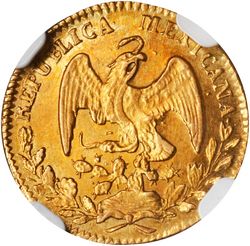
KM 378.1 Durango 1/2 Escudo 1836/4 Do RM (Stack’s-Bowers Baltimore Auction, 6 November 2013, lot 21119)
“FAT HEAD SNAKE”
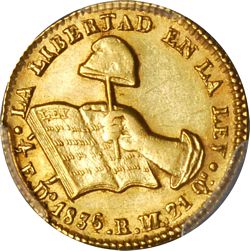
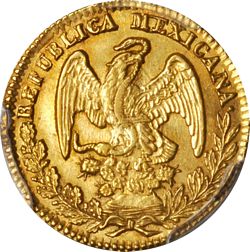
KM 378.1 Durango 1/2 Escudo 1836/4 Do RM (Stack’s-Bowers NYINC Auction, 15 January 2019, lot 43538)
The following are some identifiers for the two distinct dies, which shall work even on worn down specimens.
| Skinny head snake | Fat head snake |
| 1. Thin or skinny snake head. | 1. Fat or oversized snake head. |
| 2. Snake head between space in REPUBLICA MEXICANA. | 2. Snake head under M of MEXICANA. |
| 3. Overall thin snake. | 3. Overall fat snake. |
| 4. Gap in laurel leaves points to dot after A. | 4. Gap in laurel leaves points to foot of A. |
| 5. Less elaborate oak and laurel spears. | 5. “Heavy” oak and laurel spears. |
| 6. Cactus extends beyond snake’s tail. | 6. Snake tail extends beyond cactus. |
| 7. Laurel appears to have no berries. | 7. Berries on laurel spear. |
| 8. Coin alignment (one specimen examined) | 8. Medal alignment (one specimen examined) |
| 9. Die damage or heavy marks on eagle’s left wing. |
At first glance, I was under the impression that the Skinny Snake variety could be a mule with a die intended for the ½ Real, but it appears that is not the case, at least by comparing it to available images of earlier 1830s silver issues.
As another option, a fellow collector has recommended checking the fineness of the gold, to rule on the possibility of one of them being a contemporary counterfeit. While I have not been able to do so, I must mention that both coins seem to share the same obverse die and available images of both varieties (in grading companies census as well as auction catalogs) suggest that both varieties are found struck in “good planchets”. Furthermore, the “Fat Snake” die is found on 1837 Durango Half Escudos as well. Lastly, I did a quick search on past sales records (online) of available specimens and found four (4) of the Skinny Head Snake vs. ten (10) of the Fat Head Snake specimens, without checking for possible duplication of sales of the same specimen for either variety.
Special thanks to Gabriel Gómez Saborio and Kirk Menczer for sharing images of some of their specimens.
Another specimen of the “Fat Head Snake” variety
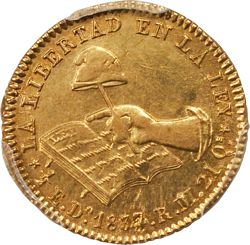
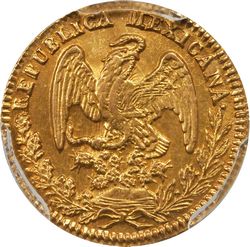
KM 378.1 Durango 1/2 Escudo 1837/4 Do RM (Stack’s-Bowers ANA auction, 21 August 2018, lot 23296)
